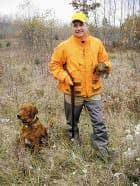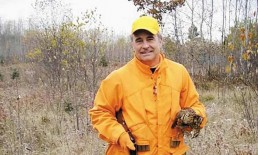Classic Michigan Grouse Hunts Involve Boots and Dogs
SHARE THIS POST
Some folks might find it strange that many ruffed grouse hunters who pursue this speedy quarry with dogs, gauge their success by how many flushes—not kills—they get in the course of an outing. Lots of flushes means they’ve found the right kind of area to put the dog into, that the dog found the birds and that the hunters had enough fortitude to crawl and crash through the thick stuff to be close enough to the dog to hear and maybe even see the birds flush.
As I head to Michigan’s Upper Peninsula this October for an annual get together of friends (this is our 29th year) I mused about the sport.
Grouse live in places that rabbits and snowshoe hares have a hard time getting through. When the hunter with his canine goes in, harvesting a bird becomes quite an accomplishment.
Pretty much the same group of us get together each year and chase these birds for seven days, usually in a different part of the U.P. For the past nine years or so, we’ve been staying in lodges, although for the first 20 we stayed in tents in one of Michigan’s many primitive campgrounds.
All 11 of us are decent shots and couple of us (not me) are close to experts. Several of us bring great pointing dogs or one of the flushing breeds, and the dogs all know what they’re doing. We hunt hard, know the kinds of habitat where grouse live and spend several hours a day in the woods, swamps and patches of brush-filled clear cuts where large trees have been lumbered. The Michigan limit on birds in the Upper Peninsula is five, and in nearly 30 years, not one of us has ever filled it. A career day for most of us is three birds. The retired conservation officer in our group, a great shot and native Yooper, once shot four and holds the camp record.
It’s not so easy to shoot a grouse.
Unless you’ve hunted grouse like we do, you might think that we are really miserable shots and probably just hang around in country taverns the whole time and blame our light game bags on the difficulty of the woods so we don’t get in trouble with our better halves. I promise, we really do try to harvest them.
Finding grouse
In the Upper Peninsula, the biggest key is finding areas that have been timbered or struck by fire between five and 10 years earlier. A stop at any of the DNR field offices is worthwhile. The personnel are happy to mark up your Michigan Gazetteer with suggested “coverts,” which is pronounced “covers.”
“Clear-cut” is a happy term in the grouse hunter’s vocabulary. Removing the big trees and their sun-blocking canopy allows smaller bushes and other flora to come back and flourish, and along with them comes the whole arboreal food chain. Grouse are opportunistic omnivores, eating some bugs, but especially subsisting on buds, berries, grasses and leaves—clover is a favorite. Seldom do you find much of this type of food in mature forests—you need to find new growth.
About 80 percent of our successful hunting takes place in or adjacent to stands of aspen, the individual trees about as thick as a man’s wrist, and so many of them so close it’s nearly impossible to swing your shotgun. We sometimes spy these from afar, their bright yellow leaves—or what’s left of them in the fall—giving the trees’ location away. We find vast expanses of aspens on national and state forests as well as on paper company land, which is often open to hunting.
Are you enjoying this post?
You can be among the first to get the latest info on where to go, what to use and how to use it!
The best parcels of aspen have an understory of other plants, particularly bracken ferns, which help ground-walking grouse stay hidden from flying predators. When you look around and notice edibles such as wintergreen berries or small buds on trees, you’ve likely found a place with grouse. It’s time to uncase your shotgun and put your dog on the ground.
A word about dogs
The main thing a dog in the thick stuff must do to enhance and not hinder your hunt is stay close and not flush grouse where you can’t see them. That said, many pointing breeds range a bit farther, so their masters adorn them with “beeper” collars, which beep to alert the hunter that the dog might be pointing a bird. (The dog pooping also causes collar beeps and commonly makes the hunter think his dog is on point.)

I have always had golden retrievers, flushers, and while the aesthetic is different, they are still effective companions in the woods, covering ground, getting birds in the air and—perhaps most important—finding the rare bird that gets shot. Whether hunting with a pointer or a retriever, you need to keep tabs on the dog and recognize when it is on scent so you can get ready to shoot. When grouse flush, they come out of brush as if shot from a cannon.
Stay ready to shoot
Even when the dog doesn’t seem birdy, grouse can explode from anywhere, so it’s a good idea to constantly watch your surroundings, thinking about what small trees are in the way of your shotgun swing, safety on, of course, but always ready to shoot.
Grouse don’t need to be hit by a huge amount of lead to hit the turf, and most of my companions shoot 20-gauge, double-barrel shotguns. It’s not a snooty, status sort of thing (well, maybe it is a little). Double guns are quick to put first and second shots in the air. A few of us use 28-gauges. Shot size is usually 7 1/2 or 8.
As mentioned, we judge our success by how many birds we moved more than how many we shot. Other factors of a good day in the grouse woods: Not being hoarse from yelling at the dog, not getting lost for an extended period, not getting the truck stuck.
A school of grouse hunting that doesn’t cotton to our particular manner of hunting has practitioners that often come closer to filling the game bag. These are “road hunters,” who use 4×4 trucks or ATVs. Some of these fellows call ruffed grouse “chickens.” They drive around until they spot a grouse or two along the side of the road, where the birds come to pick gravel. They stop their vehicle, get out, uncase their shotgun (some use a .22 rifle) and shoot the birds on the ground if they can.
One fall I found an Upper Peninsula chamber of commerce’s tabloid, a sort of annual outdoor guide, and along with stories on all manner of fishing as well as hunting for snowshoe hare, bear and deer, was a story about effective grouse hunting. The contributor, a Yooper, had essentially written a how-to guide on road hunting. He gave lots of advice on topics such as how a 12-gauge shotgun was the most effective weapon because it put the most pellets in the air, and how if you left the vehicle motor running, the grouse that had ducked into the brush at side of the road was less likely to hear your footsteps as you sneaked up on it. He concluded that while many bird hunters might question his techniques, he’d “rather eat them than miss them.”
In this writer’s opinion, grouse hunting done the right way involves hunters on foot and following dogs. Sure, we drive around looking at maps and finding habitat likely to hold grouse, but true ruffed grouse hunters don’t shoot the ones they see along the road. I don’t find legal road hunting to be reprehensible when done within the limits of the law. I just don’t think it’s as much fun as getting into the thick stuff with a close-working dog. It certainly isn’t as challenging.
I guess the bottom line is that many grouse hunters, myself included, would rather miss them than eat them.
MWO
SHARE THIS POST
You may also like...
Nothing found.
Did you enjoy this post?
You can be among the first to get the latest info on where to go, what to use and how to use it!
Dave Mull
Dave Mull of Paw Paw, Mich. has spent his career communicating the outdoors experience and runs Inner Viking Media. He enjoys kayak fishing for anything that swims in the lakes and rivers of the Midwest and beyond, and even uses his MirroCraft, from time to time. Available for seminars.
